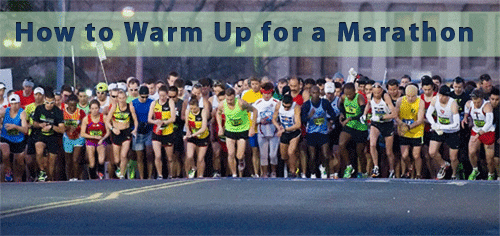
Most runners understand the value of warming up before a race.
A warm-up primes your muscles for peak performance by increasing your core body temperature, which speeds oxygen throughout the body, loosens your legs, and triggers the neural pathways between your brain and your muscles, which improves muscle contraction and power.
However, executing a proper warm-up requires energy and fuel.
For shorter races, this isn’t a concern since there is no chance of running out of glycogen. But, conserving energy and glycogen is an essential part of racing the marathon.
So, how do you balance priming your body for optimal performance with conserving energy for the long miles ahead?
The marathon warm-up starts when you wake up
The warm-up for a marathon starts hours before you cross the starting line.
You should be up at least 2.5 hours before your race.
Yes, I know this might be very early, but losing an hour of sleep won’t negatively impact your performance.
More importantly, research shows that it takes several hours for you to get your body temperature to it’s optimal levels and become fully awake, so getting up early ensures you’re fully ready to perform.
Waking up early will also allow you to be more alert, have time to fuel, use the bathroom and get your body primed for performance.
Perform a shakeout run
As soon as you wake-up, throw on your running gear, lace up the shoes, and start shuffling out the door for a short shakeout run or walk.
You shouldn’t be running hard on your shakeout run. The main goal is to get blood and oxygen flowing to the muscles, so a slow jog or shuffle is sufficient. Run easy for about 10 minutes, include some light stretching if you feel tight, and then return to the hotel to get in your pre race meal, hit the bathroom, and get ready to head to the starting line.
As I’ve covered more in-depth in this article, a shakeout run will stimulate your central nervous system, get blood flowing to the muscles, calm your nerves, and help you use the bathroom. More importantly, it allows you to do all these things and still have time to rest and refuel so it doesn’t deplete your glycogen stores.
After you finish your shakeout run you can have a small breakfast, shower, relax and have plenty of time to get to the starting line stress-free.
At the starting line
Step 1: Staying warm
Since you’ll likely be standing in your starting corral for quite a long time before the race starts, your primary concern is conserving energy by staying warm and dry.
Be sure to take extra clothes with you that you don’t mind throwing away. Find that ratty sweatshirt/pair of gloves/hat/sweatpants your spouse has been nagging you to throw out for years. If you don’t have any clothing items ready to be ditched, head to Wal-Mart or a cheap clothing store and buy some warm weather clothes you could run in for a mile or two. You can wear these warm items in the corral when you’re standing in the cold and have nowhere to move to stay warm. Once you get running past the first mile or two, your body will begin to warm up and you can shed them. Most marathons pick up discarded clothing at the start and donate to charity.
The warmer you can stay, the less energy you’ll expend tying to keep warm. Error on the side of too warm rather than slightly cold.
Step 2: warming up your legs in a small space
The next important piece is preparing your legs for optimal efficiency.
A dynamic stretch that promotes proper hip extension, like a lunge, will reduce internal resistance and improve the efficiency of your stride. Not only will this prime your legs for the early miles, but could be critical to preventing muscle cramps late in a race.
Because you don’t have a lot of room, a dynamic stretching routine is the perfect pre-marathon warm-up. It takes less than 5 minutes and can be done with very little room.
The specific dynamic stretching routine you perform can be any combination of exercises you prefer. The lunge matrix is an effective routine developed by Gary Gray and popularized by Jay Johnson, but you can also perform ankle rolls, leg swings and skipping drills.
It is important to note that marathon race day should not be the first time you perform the lunge matrix or any other dynamic stretching routine. It will make you a little sore the first few times. However, it is a very effective pre-run and pre-workout routine you should be implementing daily.
Step 3: Getting your lungs ready
As for the metabolic system (your heart, lungs, breathing, etc.), it’s not as critical to be primed for performance from the gun like it is for shorter races.
In the marathon, you can use the first mile or two as a warm-up since you ideally want to be a little slower than marathon pace the first few miles anyway. This will also prevent you from starting too fast, a common racing mistake.
Don’t take the marathon warm-up lightly. After months of hard workouts and long runs, you want to give yourself the best chance of success. Make sure you prime all your energy systems and your body for optimal performance while also conserving energy.




